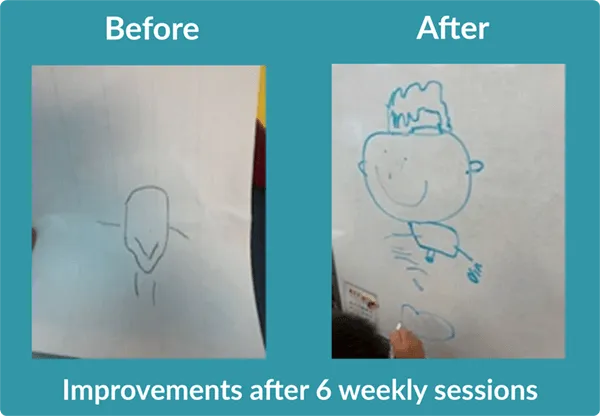Primitive Reflex Integration Case Studies
Neurodevelopmental Movements Support Goal Achievement
First-grader shows improved confidence and fine motor skills
This therapist used neurodevelopmental movements—including rhythmic movements and reflex integration—from the Brain and Sensory Foundations course to increase her client’s regulation, motor skills, and confidence. After just six sessions and one round of the 5-Step Balance process, his drawing abilities greatly improved and he met his goal of being able to jump into the deep end of the pool.
Submitted by Lisa Brown, OTR

| Before | After |
|---|---|
| Required assistance to follow through with newer or unfamiliar tasks | Able to participate more easily in the therapy activities suggested to him |
| Poor body awareness | Increased awareness of his body in space; feels more successful in his movements |
| Initial body illustrations showed little to no detail | After therapy, his body illustrations were clearer, with proper features and better connections between body parts |
| Poor self-confidence; stuck with familiar activities and didn't branch out | Used the 5-Step Balance process to support goal of swinging from trapeze into a ball pit; later jumped into the deep end of the pool |
A is a 6-year-old boy. He is seen in a small outpatient clinic. A has difficulties with self-regulation, social skills, self-confidence, body awareness, interoception, putting on clothing with regards to orientation, and eye hand coordination skills. He has poor core muscle strength and decreased visual skills (tracking and convergence). He is very focused on his own thoughts and needs assistance to follow through with newer or unfamiliar tasks.
Goals: body awareness: draw a person with features; interoceptive awareness: when he needs to urinate, properly orient clothing, overall improvement of core muscles
He has a personal goal to jump into the deep water at the pool.
I have chosen to do Asymmetrical Tonic Neck Reflex [ATNR], Moro reflex, and Fear Paralysis reflex. Moro as he tries to dominate an activity and is inflexible to try new things. Fear Paralysis as he is frightened to move his body in space, is stuck with his familiar activities and doesn’t branch out. ATNR for his difficulty with balance and coordination, visual tasks, bilateral coordination and limited separation of his head and eyes.
I chose to begin each session with Brain Tune Up followed with Rhythmic rocking [from the Brain and Sensory Foundations course] in all of the directions. A did very well in following the Brain Tune Up movements, and accepted the rocking well. He commented it let him feel calm and ready to do our activity. He moved through the passive integration movements for Moro [from the Brain and Sensory Foundations course].
He participated in the 5-Step Balance process 1 time before the sessions came to an end:
A stated that his intention was to hang from the trapeze bar and let go to land into the ball pit. Goal Statement: “I will hold the bar, count to 3 and let go to fall into the ball pit all by myself”. After completing the 5-Step Balance, A was able to hold trapeze bar and count to 4 and then drop into ball pit.
A was able to participate more easily in the therapy activities suggested to him over the course of the 6 weeks. He demonstrated increased awareness of his body in space, as his draw-a-person was clearer with proper features and better connections between body parts (see Before and After photo above). A was able to feel more successful in his movements in the clinic and his mother reported that he jumped into the deep end of the pool the week after the 5-Step process.
(Edited, emphasis added)
*Disclaimer: The activities in the Brain and Sensory Foundations curriculum make use of the natural processes of neuroplasticity and development that are innately wired in the design of human beings to promote maturity and function. These activities appear to calm, organize, and mature the neuro-sensory-motor systems just as we see in the healthy development of human infants. Individual results may vary, and we do not claim to offer a diagnosis or cure for any specific condition or disorder. The Brain and Sensory Foundations activities appear to improve overall functioning resulting in measurable improvements for a range of conditions as demonstrated in over 1800 case studies from participants.

